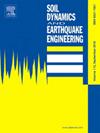含塑性和非塑性细粒砂中微生物诱导的部分饱和液化减缓性能
IF 4.2
2区 工程技术
Q1 ENGINEERING, GEOLOGICAL
引用次数: 0
摘要
细粒砂土地震液化的缓解是一个挑战,需要有效的策略。本研究探讨了微生物诱导部分饱和(MIPS)作为一种生物岩土技术,对提高含塑性细砂土的抗液化能力的效果。通过利用本地微生物的自然代谢过程,该方法在土壤基质中引入了生物气生产,有效地降低了其饱和度。这种局部去饱和改变了土壤对循环加载的响应,旨在减轻动力加载条件下液化的风险。一系列不排水应变控制循环剪切试验的实验结果表明,即使饱和度适度降低,也能显著提高土壤抗地震液化的稳定性。研究扩展到分析MIPS处理低塑性粘土含量砂土的有效性,从而深入了解微生物活动、土壤质地和液化潜力之间的相互作用。结果表明,虽然塑性在改善土壤的循环响应中起着关键作用,但MIPS处理的影响仍然值得注意,即使在具有塑性细粒的砂土中也是如此。此外,还引入了一个改进的预测公式,其中包含了一个校准参数,以考虑细粒塑性对超孔隙压力产生的影响。本文章由计算机程序翻译,如有差异,请以英文原文为准。
Performance of microbial induced partial saturation for liquefaction mitigation in sands containing plastic and non-plastic fines
The mitigation of seismic soil liquefaction in sand with fine content presents a challenge, demanding efficient strategies. This research explores the efficacy of Microbial-Induced Partial Saturation (MIPS) as a bio-geotechnical technique to improve the liquefaction resistance of sandy soils with plastic fines. By leveraging the natural metabolic processes of indigenous microorganisms, this method introduces biogenic gas production within the soil matrix, effectively reducing its degree of saturation. This partial desaturation alters the soil's response to cyclic loading, aiming to mitigate the risk of liquefaction under dynamic loading conditions. Experimental results from a series of undrained strain-controlled cyclic shear tests reveal that even a modest reduction in saturation significantly enhances the soil's stability against seismic-induced liquefaction. The investigation extends to analyzing the effectiveness of the MIPS treatment in sands with low-plasticity clay content, offering insights into the interaction between microbial activity, soil texture, and liquefaction potential. Results show that while plasticity plays a key role in improving the cyclic response of soils, the influence of MIPS treatment remains noteworthy, even in sand with plastic fines. Additionally, a modified predictive formulation is introduced, incorporating a calibrated parameter to account for the influence of fines' plasticity on excess pore pressure generation.
求助全文
通过发布文献求助,成功后即可免费获取论文全文。
去求助
来源期刊

Soil Dynamics and Earthquake Engineering
工程技术-地球科学综合
CiteScore
7.50
自引率
15.00%
发文量
446
审稿时长
8 months
期刊介绍:
The journal aims to encourage and enhance the role of mechanics and other disciplines as they relate to earthquake engineering by providing opportunities for the publication of the work of applied mathematicians, engineers and other applied scientists involved in solving problems closely related to the field of earthquake engineering and geotechnical earthquake engineering.
Emphasis is placed on new concepts and techniques, but case histories will also be published if they enhance the presentation and understanding of new technical concepts.
 求助内容:
求助内容: 应助结果提醒方式:
应助结果提醒方式:


